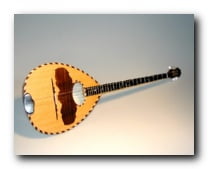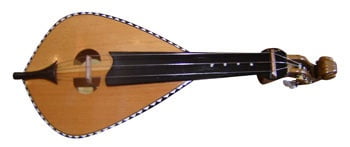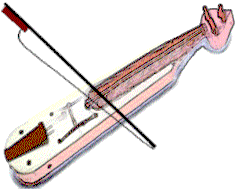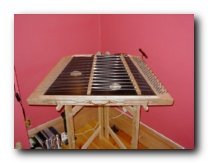There are numerous stringed instruments in Greek music since the antiquity. Most of these traditional music instruments have been adding to the harmony of the traditional and folk Greek music, and have been used by musicians for decades.
Most of these instruments originate from the ancient Greek music or from the folk tradition. Here, we will be presenting the most popular and commonly used ones.
Traditional Stringed Instruments in Greek Music

Bouzouki: probably the most distinctive instrument in Greek music; it has 3 pair of strings – although there is a 4 stringed bouzouki introduced and used by Manolis Chiotis.
Greek bouzouki produces the characteristic sound of folk, laika and rempetika songs.
In many parts of Greece it is called by different names, such as bouzouri or kivouri.

Cretan Lyra: The lyra of Crete is an instrument made of wood, carved to create the sound box. It has three strings and is played with a bow.
The lyra player has to touch the strings with his nail from the side without tapping on them.
The Cretan lyra is different than the lyra used in Asia Minor that has four strings and is tuned the same way as the violin. There are also different lyras in Macedonia and Thrace that are usually made in the shape of a pear.

Pontian Lyra: Another popular type of lyra, the one that comes from Pontos, which is also called kementzes.
The Pontian lyra has three thin steel strings and the lyra player has to tap on them, opposite from the Cretan lyra.

Tambouras: Tampouras or tambouras is made of walnut tree wood and has three double strings, same as the bouzouki, but is differently tuned.
Some players use a pick or bow to play it.
The neck of tambouras is divided into commas and not semitones, therefore the sound produced is totally different, since it is deep and sweet.

Baglamas: Mpaglamas or baglamas is the small bouzouki.
Its name comes from the Turkish word baglama which means knot.
Baglamas or mpaglamas has three pairs of strings and it used to be the predominant instrument in rembetika songs, while today it is more of an accompaniment instrument. Baglamas is usually 35cm long and comes with different necks.

Outi: Outi or Oud in English is a wooden instrument – as the word outi in Arabic means.
Outi belongs to the family of lutes and used to be a simple instrument without a neck. It has five double strings and it was played originally with the fingers and later with a pick.
It is a solo instrument with a very characteristic sound, and the player can produce an additional sound tapping his hand on the lower strings. It is considered one of the most difficult instruments to learn how to play since it is not divided in semitones or commas.

Laouto: Laouto or lute is a stringed instruments used in many genres of the Greek music, especially in the folk songs of the islands.
Laouto has a small body, long neck and a deep body of 16cm. It has four strings which are usually tuned in a higher octava.
Laouto is an instrument of accompaniment, and is played with a plume. According to some music historians, the laouto was introduced to Europe by the Spaniards who brought it from the Arabic countries.

Kanonaki: Kanonaki is a triangle shaped instrument and is tuned according to the chromatic scale. It has 72 plastic strings that produce 24 notes each.
The most common type of kanonaki is played with two springs that fit to the index fingers of both hands.
According to the historians, the Greek mathematician Pythagoras was trying to determine the different notes of the ancient form of the instrument, based on the thickness and length of the strings.
Kanonaki is considered one of the oldest Greek music instruments and today there are very few kanonaki players.

Santouri is a traditional Greek music instrument, the more modern version of the ancient Epigonio and Psalterion.
Santouri derives from the Persian name “santir” and it is a trapezoid shaped instrument with a small sound box.
Santouri has 120-140 strings and can produce 32 notes. They are made of steel while the bass strings are made of copper.
It is played using mallets with cotton at their end, in order to produce a softer and sweeter sound. Again, few players of santouri exist today in Greece.